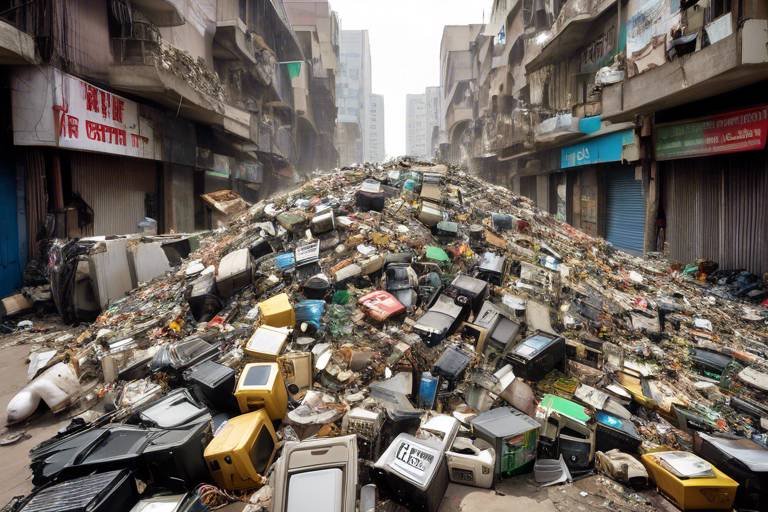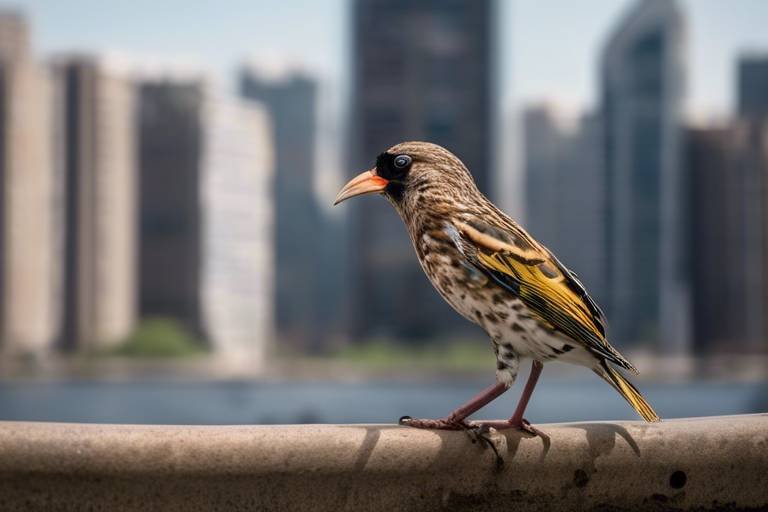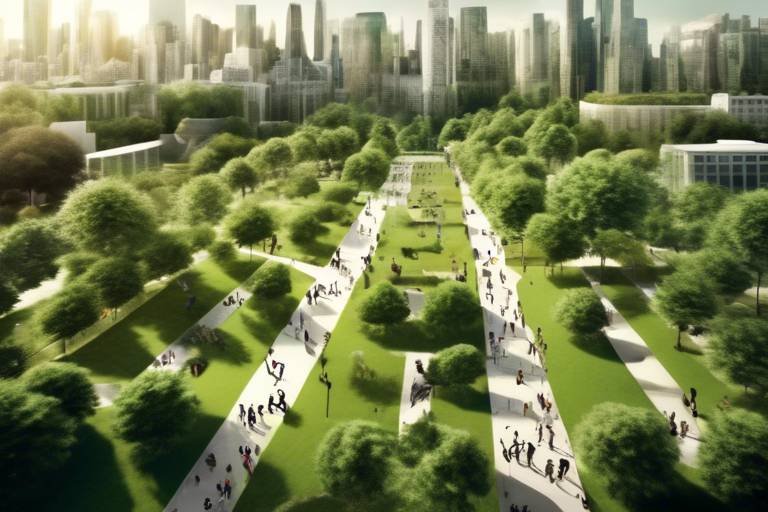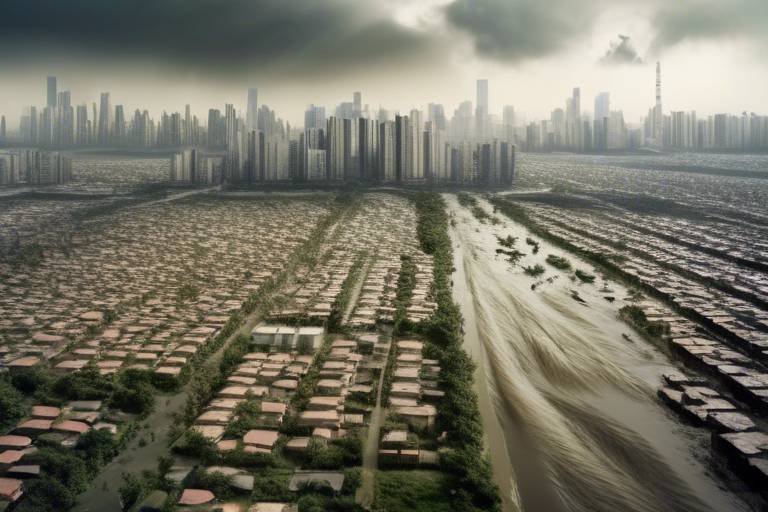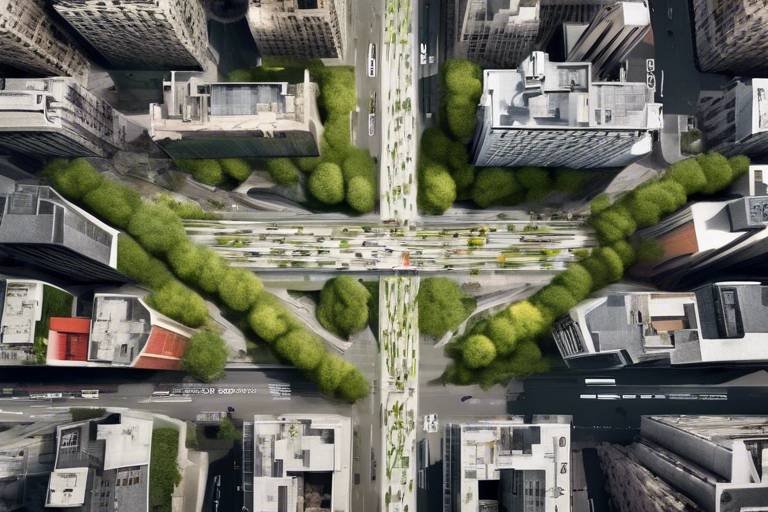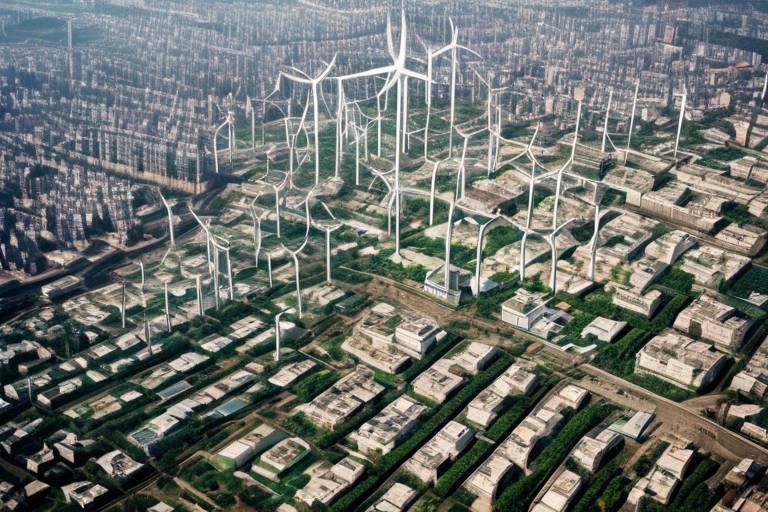Reducing Urban Light Pollution Through Sustainable Practices
In our fast-paced urban environments, the glow of city lights has become a familiar sight. However, this excessive artificial illumination is not just a nuisance; it represents a growing problem known as light pollution. As we navigate through our bustling streets, we often overlook the profound implications this phenomenon has on both our health and the surrounding ecosystem. The good news? By adopting sustainable practices, we can significantly reduce light pollution while enhancing our nighttime experience.
So, what exactly is light pollution? It's the brightening of the night sky caused by artificial lights, which disrupts the natural darkness of our environment. This disruption can lead to a cascade of negative effects, not only on wildlife but also on our own well-being. Imagine trying to sleep in a room flooded with bright light; it's no wonder that many city dwellers struggle with sleep issues. The need for effective strategies to combat this issue has never been more urgent.
Light pollution encompasses various forms, including glare, skyglow, and light trespass. Each type has its own unique challenges and consequences. For instance, glare can create hazardous driving conditions, while skyglow obscures our view of the stars, robbing us of the beauty of a clear night sky. This section will delve deeper into the causes and effects of light pollution, shedding light on its pervasive presence in urban settings.
Light pollution is not just an aesthetic issue; it has significant environmental consequences. Wildlife and ecosystems are particularly vulnerable to the disruptions caused by artificial lighting. For example, many species depend on natural light cues for critical behaviors such as navigation and reproduction. When these cues are altered, it can lead to dire consequences for various species and the ecosystems they inhabit.
Consider the plight of migratory birds. These incredible creatures have navigated the skies for millennia, relying on the moon and stars to guide them. However, with the rise of urban lighting, many birds are becoming disoriented. They may veer off course, leading to exhaustion, collisions with buildings, or even death. Such disruptions can have a ripple effect on biodiversity, as the delicate balance of ecosystems is thrown into chaos.
Artificial lights can confuse migratory birds, leading them off course. This phenomenon not only threatens bird populations but also impacts the entire food chain. When birds fail to reach their breeding grounds, it can lead to a decline in their numbers, affecting predators and plants that rely on them for pollination. This interconnectedness highlights the urgent need to mitigate light pollution.
Nocturnal animals, such as owls and bats, face unique challenges due to urban lighting. These species have adapted to hunt and reproduce in the dark, but artificial light can disrupt their natural behaviors. For instance, illuminated areas may attract insects, which can lure nocturnal predators into dangerous situations, making them more vulnerable to human activity. It’s a stark reminder that our actions during the day can have unintended consequences at night.
Light pollution doesn’t just affect wildlife; it also has profound implications for human health. Exposure to excessive artificial light can disrupt our circadian rhythms, the internal clock that regulates sleep-wake cycles. This disruption can lead to a host of health issues, including insomnia, anxiety, and even more severe conditions like obesity and depression. As urban populations continue to grow, it’s crucial to address these health concerns by implementing sustainable lighting practices.
Implementing sustainable lighting practices can significantly reduce light pollution and its associated impacts. By focusing on energy-efficient fixtures and smart lighting technologies, we can create a more harmonious relationship between urban living and the natural environment. These solutions not only minimize light pollution but also enhance nighttime visibility and safety.
Adopting LED and other energy-efficient lighting options can minimize light pollution. These technologies are not only more environmentally friendly but also cost-effective in the long run. For instance, LEDs consume less energy and have a longer lifespan compared to traditional bulbs. By making the switch, we can reduce our carbon footprint while simultaneously addressing the issue of light pollution.
Smart lighting systems are revolutionizing the way we illuminate our surroundings. These innovative technologies can adapt to environmental conditions, automatically dimming or brightening based on the presence of people or natural light. Such adaptability can drastically reduce excess light, contributing to a more sustainable urban landscape. Imagine walking through a city where the lights adjust to your movements, creating a safer and more pleasant environment.
- What are the main causes of light pollution? Light pollution is primarily caused by excessive artificial lighting from streetlights, buildings, and advertising signs.
- How does light pollution affect human health? It can disrupt sleep patterns and circadian rhythms, leading to various health issues.
- What can I do to help reduce light pollution? You can switch to energy-efficient bulbs, use curtains to block excess light, and advocate for better urban lighting policies.

Understanding Light Pollution
Light pollution, in its simplest form, is the overabundance of artificial light in our urban landscapes. Imagine stepping outside on a clear night, only to find that the stars are hidden behind a veil of glaring streetlights and neon signs. This overwhelming illumination not only obscures our view of the cosmos but also disrupts the delicate balance of our ecosystems and affects our health. But what exactly causes this phenomenon? It can be attributed to various factors, including poorly designed street lighting, excessive advertising, and even the glow from our electronic devices.
There are several types of light pollution that we encounter daily:
- Skyglow: The bright halo that appears over populated areas, obscuring our view of celestial bodies.
- Glare: Excessive brightness that causes visual discomfort, making it hard to see in the dark.
- Light trespass: Unwanted or intrusive light spilling over into areas where it is not needed or wanted.
- Clutter: An excessive grouping of lights that creates confusion and distraction, often seen in urban settings.
The impact of light pollution on urban environments is profound. It not only affects our ability to enjoy a peaceful night sky but also has significant implications for wildlife and human health. For instance, nocturnal animals, which rely on darkness for hunting and mating, find their natural behaviors disrupted. Similarly, humans are not immune; exposure to artificial light at night can interfere with our sleep patterns, leading to a myriad of health issues. Studies have shown that cities with high levels of light pollution often report increased rates of sleep disorders, anxiety, and even obesity.
As we delve deeper into the implications of light pollution, it becomes evident that addressing this issue is not merely about aesthetics; it’s about preserving our natural environment and improving our quality of life. By understanding the causes and consequences of light pollution, we can begin to implement sustainable practices that promote a healthier, more balanced coexistence with our surroundings.

Environmental Impacts of Light Pollution
Light pollution is not just an aesthetic issue; it has profound environmental impacts that ripple through our ecosystems. When we think of urban areas, we often picture bright city lights illuminating the night sky. However, this constant glow can disrupt the delicate balance of nature, affecting both wildlife and plant life. The consequences of excessive artificial lighting are far-reaching, leading to changes in behavior, reproduction, and even migration patterns of various species.
One of the most significant effects of light pollution is its impact on wildlife. Many species rely on natural light cues for their daily activities. For instance, nocturnal animals have evolved to hunt and thrive in the darkness, using the cover of night to evade predators. However, the introduction of artificial lighting can confuse these animals, making it harder for them to find food and reproduce. This disruption can lead to a decline in populations, threatening biodiversity in urban environments.
Moreover, light pollution can alter the growth patterns of plants. Plants have adapted to rely on natural light cycles to regulate their growth and flowering. When artificial lights are introduced, particularly in urban settings, it can lead to misalignment in these cycles. For example, some plants may bloom prematurely in response to artificial light, which can disrupt the entire ecosystem as pollinators may not be available at the time of flowering. This misalignment can ultimately lead to reduced plant populations and the animals that depend on them.
As mentioned earlier, the effects of light pollution on wildlife are profound. Many species depend on the natural rhythms of day and night for their survival. For example, migratory birds rely on the stars and moon for navigation. When urban areas are bathed in artificial light, these birds can become disoriented, leading them to fly off course. This confusion can result in increased mortality rates and a decline in bird populations, ultimately affecting the entire ecosystem.
The impact of light pollution on migratory birds is particularly alarming. During migration, birds often travel long distances, relying on celestial navigation. When they encounter bright lights in urban areas, they can become trapped and disoriented, leading to collisions with buildings and other structures. This phenomenon not only endangers individual birds but can also have cascading effects on their populations. For instance, studies have shown that cities with higher levels of light pollution experience significant declines in migratory bird numbers. This disruption can alter local biodiversity, as the absence of these birds can affect the plants they pollinate and the insects they control.
Nocturnal animals, such as owls and bats, face unique challenges due to light pollution. These creatures have adapted to hunt and navigate in the dark, but artificial lighting can impair their ability to do so. For example, bright streetlights can make it difficult for owls to spot their prey, leading to reduced hunting success. Additionally, light pollution can affect the reproductive behaviors of these animals, as many rely on darkness for mating rituals. The result is a decline in nocturnal species, which can further disrupt the balance of the ecosystem.
In conclusion, the environmental impacts of light pollution are significant and multifaceted. From disrupting wildlife behavior to altering plant growth, the consequences are far-reaching and demand immediate attention. As urban areas continue to expand, it is crucial to adopt sustainable lighting practices that minimize these impacts while preserving the natural environment.
- What is light pollution? Light pollution refers to excessive artificial light that disrupts ecosystems, human health, and astronomical observations.
- How does light pollution affect wildlife? Light pollution can confuse animals, disrupt their natural behaviors, and lead to declines in populations.
- What are some strategies to reduce light pollution? Implementing energy-efficient lighting, using smart lighting technologies, and promoting community awareness can help reduce light pollution.

Effects on Wildlife
When we think about light pollution, it’s easy to overlook its profound impact on wildlife. Many species have evolved over millennia to rely on natural light cues for their survival. For instance, sea turtles use the moonlight to find their way to the ocean after hatching. When artificial lights are introduced, they can become disoriented, leading them away from the safety of the sea. This is just one example of how light pollution can disrupt the delicate balance of nature.
Moreover, the effects of light pollution extend beyond just navigation. It can also interfere with reproductive behaviors. Many animals, including amphibians and insects, depend on darkness to mate and reproduce. Artificial lights can confuse these natural processes, leading to decreased populations and even extinction in some cases. The consequences ripple through the ecosystem, affecting not just the species directly impacted by the light, but also those that rely on them for food or other ecological functions.
Consider the plight of nocturnal animals as another example. These creatures, adapted to thrive in the dark, face significant challenges due to urban lighting. Their hunting and foraging behaviors are disrupted, as they often rely on the cover of darkness to ambush prey. This disruption can lead to a decline in their populations, which in turn affects the entire food chain. For instance, if a predator species declines, the prey population may explode, leading to overgrazing and further ecological imbalance.
One striking case is that of the firefly. These enchanting insects rely on bioluminescence for mating signals. The glow of city lights can drown out their signals, making it difficult for them to find mates. As a result, firefly populations are dwindling in urban areas, robbing us of their beauty and the essential role they play in the ecosystem as pollinators.
In addition to these direct effects, light pollution can also alter the timing of natural events. This phenomenon, known as phenological shifts, can lead to mismatches in food availability. For example, if plants bloom earlier due to artificial lighting, but the insects that pollinate them do not adjust their life cycles accordingly, it can lead to decreased plant reproduction and a cascading effect on the entire ecosystem.
To illustrate the various effects of light pollution on wildlife, consider the following table:
| Animal | Effect of Light Pollution | Consequence |
|---|---|---|
| Sea Turtles | Disorientation due to artificial lights | Increased mortality rates |
| Birds | Disruption of migration patterns | Population decline |
| Fireflies | Interference with mating signals | Decreased reproduction rates |
| Nocturnal Mammals | Disruption in hunting behavior | Population decline |
As we can see, the effects of light pollution on wildlife are both diverse and serious. It’s crucial that we recognize these impacts and take steps to mitigate them. By adopting sustainable lighting practices, we can help preserve the natural behaviors of wildlife and maintain the ecological balance that is vital for our planet’s health.
- What is light pollution? Light pollution is the excessive or misdirected artificial light that brightens the night sky, disrupting ecosystems and human health.
- How does light pollution affect wildlife? It disrupts natural behaviors such as navigation, reproduction, and hunting, leading to population declines and ecological imbalances.
- What can be done to reduce light pollution? Implementing energy-efficient lighting, using smart lighting technologies, and adopting community awareness programs can significantly reduce light pollution.

Bird Migration Disruption
Birds are remarkable creatures, often navigating thousands of miles during their migratory journeys, relying on the natural cues of the environment to guide them. However, the introduction of artificial light into urban landscapes has thrown a significant wrench into this age-old process. Imagine a bird, soaring high above the city, only to find itself disoriented by the bright glow of streetlights and billboards. This confusion can lead to catastrophic consequences, including collisions with buildings, exhaustion from deviating from their intended path, and even failure to reach vital breeding grounds.
Research has shown that many migratory birds are attracted to artificial lights, especially during foggy or overcast nights. This phenomenon, known as "light pollution," can create a false sense of direction, causing birds to spiral downwards, becoming trapped in urban areas. The result? A staggering number of birds are injured or killed each year due to these collisions. According to studies, it is estimated that urban light pollution contributes to the deaths of millions of birds annually, with species like the Common Nightingale and Red-eyed Vireo being particularly affected.
Moreover, the disruption does not end with physical harm. When birds are misled by lights, they may also miss crucial feeding opportunities or fail to mate successfully. This disruption can alter entire ecosystems, as birds play a vital role in controlling insect populations and pollinating plants. The cascading effects of these disruptions can lead to imbalances in local biodiversity, affecting not just birds but other wildlife and plant species as well.
So, what can be done to mitigate this issue? Urban planners and city officials can take actionable steps to minimize light pollution and its effects on migratory birds. Implementing shielded lighting that directs light downward rather than outward can significantly reduce the impact on avian navigation. Additionally, using warmer-colored lights can help lessen the attraction of birds to artificial lighting. Simple measures, such as turning off lights during peak migration periods, can also make a substantial difference.
In conclusion, the disruption of bird migration caused by artificial lighting is a pressing issue that requires immediate attention. By adopting sustainable lighting practices, we can help ensure that these magnificent creatures continue their journeys unhindered, preserving the delicate balance of our ecosystems.
- What is light pollution? Light pollution refers to excessive or misdirected artificial light that disrupts natural darkness.
- How does light pollution affect birds? It confuses their navigation, leading to collisions and disrupted migration patterns.
- What can cities do to reduce light pollution? Cities can implement shielded lighting, use warmer colors, and turn off unnecessary lights during migration seasons.

Impact on Nocturnal Animals
Nocturnal animals, those fascinating creatures that thrive in the dark, face an uphill battle in our brightly lit urban environments. Imagine trying to navigate a maze while someone shines a flashlight in your eyes; this is the daily reality for many of these animals. Artificial lighting disrupts their natural behaviors, making it increasingly difficult for them to hunt, mate, and thrive. Studies have shown that species like owls, bats, and various insects rely heavily on the darkness to carry out essential life functions. When urban areas are flooded with light, it’s not just a nuisance; it’s a serious threat to their survival.
For instance, many nocturnal predators depend on the cover of darkness to stalk their prey. The bright lights of a city can create a false sense of security for prey species, allowing them to roam freely, which in turn makes hunting more difficult for predators. This imbalance can lead to declining populations of nocturnal hunters, which can have a cascading effect on the entire ecosystem. The delicate web of life is easily disrupted when one strand begins to fray.
Moreover, artificial light can confuse nocturnal animals' internal clocks, throwing off their natural rhythms. Animals like fireflies, which use bioluminescence to attract mates, are particularly vulnerable; excess light can drown out their signals, leading to decreased reproduction rates. Insects, which are crucial for pollination and serve as a food source for many nocturnal animals, also suffer as their natural behaviors become altered. This is a classic case of the ripple effect, where one change leads to many unforeseen consequences.
To illustrate the impact of light pollution on nocturnal animals, consider the following table that summarizes key species affected and their behavioral changes:
| Species | Impact of Light Pollution | Behavioral Changes |
|---|---|---|
| Owls | Reduced hunting success | Increased activity during the day |
| Bats | Disruption of echolocation | Altered feeding patterns |
| Fireflies | Decreased mating success | Reduced light emission |
In summary, the impact of artificial lighting on nocturnal animals is profound and far-reaching. It's essential to recognize that every light bulb turned on in our cities can have a ripple effect on the wildlife around us. As we push for more sustainable practices, we must consider how we can create urban environments that respect and accommodate the natural behaviors of these creatures. After all, the nighttime world is just as vibrant and essential as the daytime one, and it deserves our protection.
- What is light pollution? Light pollution refers to excessive or misdirected artificial light that brightens the night sky and disrupts ecosystems.
- How does light pollution affect nocturnal animals? It disrupts their natural behaviors, such as hunting and mating, and can lead to population declines.
- What can be done to reduce light pollution? Implementing energy-efficient lighting, using smart lighting technologies, and promoting awareness can help mitigate light pollution.

Human Health Concerns
Have you ever noticed how a bright streetlight outside your window can make it nearly impossible to get a good night's sleep? This is not just a personal annoyance; it’s a widespread issue tied to the phenomenon of light pollution. Excessive exposure to artificial lighting, especially during the night, can wreak havoc on our circadian rhythms, which are the natural processes that regulate our sleep-wake cycles. When these rhythms are disrupted, it can lead to a range of health problems that affect our overall well-being.
Studies have shown that individuals living in areas with high levels of light pollution often experience sleep disorders, increased stress levels, and even a higher risk of chronic diseases. Imagine trying to sleep in a room flooded with bright, white light; your body struggles to produce melatonin, the hormone that helps regulate sleep. This disruption can lead to insomnia, fatigue, and even mood disorders. As a result, many urban dwellers find themselves in a vicious cycle of sleeplessness and stress, which can have profound effects on their health.
Moreover, the implications of light pollution extend beyond just sleep disturbances. Research indicates that prolonged exposure to artificial light at night can increase the risk of serious health issues, including:
- Obesity: Disrupted sleep patterns can lead to weight gain due to hormonal imbalances.
- Depression: Lack of quality sleep is closely linked to mood disorders.
- Cardiovascular diseases: Studies suggest a correlation between light pollution and increased heart disease rates.
- Cancer: Some research points to a potential link between nighttime light exposure and breast cancer risk.
These health concerns are particularly alarming when you consider that urban areas are often bathed in artificial light, making it challenging for residents to escape its effects. The bright lights that illuminate our streets and buildings might seem harmless, but they can significantly impact our health and quality of life.
In addition to the physical health risks, there are also psychological impacts associated with light pollution. The constant exposure to artificial light can lead to a sense of disconnection from the natural world, which is essential for our mental health. Just think about how refreshing it feels to be under a starry sky, away from the hustle and bustle of city life. This natural connection is often lost in urban settings, contributing to feelings of anxiety and stress.
Addressing light pollution is not just about improving our night skies; it’s also about protecting our health. By implementing sustainable lighting practices, we can create a healthier urban environment that promotes better sleep and overall well-being. Simple changes, such as using shielded light fixtures and opting for warm-colored lights, can make a significant difference. It’s time to take action and prioritize our health by reducing the light pollution that surrounds us.
- What is light pollution? Light pollution refers to excessive or misdirected artificial light that brightens the night sky and disrupts natural darkness.
- How does light pollution affect sleep? Excessive artificial light can interfere with the body's production of melatonin, leading to sleep disorders and poor sleep quality.
- What health issues are linked to light pollution? Light pollution is associated with various health problems, including obesity, depression, cardiovascular diseases, and even cancer.
- How can we reduce light pollution? Implementing sustainable lighting solutions, such as using energy-efficient fixtures and smart lighting technologies, can help minimize light pollution.

Strategies for Sustainable Lighting
Implementing sustainable lighting practices is crucial for minimizing light pollution in urban areas. As cities continue to grow, the challenge of balancing aesthetic illumination with ecological responsibility becomes more pressing. Fortunately, there are several effective strategies that can help us achieve this balance. By adopting innovative technologies and energy-efficient solutions, we can not only enhance nighttime visibility but also preserve the natural environment.
One of the most impactful measures is the transition to energy-efficient lighting solutions. Traditional incandescent bulbs are notorious for wasting energy and contributing to light pollution. In contrast, LED lighting has emerged as a game-changer. These fixtures consume significantly less energy and have a longer lifespan, which means fewer replacements and less waste. Moreover, LEDs can be designed to emit light in specific directions, reducing unwanted glare and light spill into the night sky. Imagine a city where streetlights illuminate only the roads and sidewalks, leaving the stars visible above. This is not just a dream; it can be our reality with the right choices.
In addition to LEDs, the implementation of smart lighting technologies can further enhance sustainability efforts. Smart lighting systems utilize sensors and adaptive controls to adjust brightness based on real-time conditions. For example, streetlights can dim when no pedestrians are present, conserving energy and reducing light pollution. This not only saves money for municipalities but also minimizes the environmental impact. The integration of smart technology into urban lighting can lead to a more responsive and efficient system, much like a well-tuned orchestra that plays harmoniously without overwhelming the audience.
To illustrate the effectiveness of these strategies, consider the following table that compares traditional lighting with modern sustainable alternatives:
| Lighting Type | Energy Consumption | Average Lifespan | Light Pollution Potential |
|---|---|---|---|
| Incandescent Bulbs | High | 1,000 hours | High |
| Compact Fluorescent Lamps (CFLs) | Moderate | 10,000 hours | Moderate |
| LEDs | Low | 25,000 hours | Low |
As shown in the table, LEDs not only consume less energy but also have a significantly longer lifespan and lower potential for contributing to light pollution. This makes them an ideal choice for urban areas aiming to reduce their environmental footprint.
Moreover, community involvement plays a vital role in the success of these sustainable lighting initiatives. Educating residents about the importance of reducing light pollution can foster a sense of responsibility and encourage them to adopt practices such as using shields on outdoor lights or selecting warm-colored bulbs that are less disruptive to wildlife. When communities come together, they can create a collective impact that resonates beyond individual actions.
In conclusion, the strategies for sustainable lighting are not just about reducing light pollution; they are about creating a better quality of life for both humans and wildlife. By embracing energy-efficient lighting solutions and smart technologies, we can illuminate our cities responsibly, ensuring that both our nights and our ecosystems thrive. So, let’s take these steps together and pave the way for a brighter, yet darker, future.
Q1: What is light pollution?
A1: Light pollution refers to the excessive or misdirected artificial light that disrupts natural darkness, affecting ecosystems, human health, and astronomical observations.
Q2: How can I reduce light pollution in my home?
A2: You can reduce light pollution by using outdoor lighting that is shielded, selecting warm-colored bulbs, and turning off lights when they are not needed.
Q3: Are there any benefits to reducing light pollution?
A3: Yes! Reducing light pollution can improve wildlife habitats, enhance human health by promoting better sleep, and allow for clearer views of the night sky.

Energy-Efficient Lighting Solutions
In the quest to combat light pollution, have emerged as a beacon of hope. These technologies not only help in minimizing excess light but also contribute to significant energy savings and reduced carbon footprints. Imagine walking through a city where the glow of streetlights is soft and warm, illuminating paths without spilling light into the night sky. This is the promise of energy-efficient lighting. One of the most popular options in this category is LED lighting. LEDs, or light-emitting diodes, use a fraction of the energy compared to traditional incandescent bulbs, making them a smart choice for urban environments. Not only do they last longer—up to 25 times more than incandescent bulbs—but they also produce less heat, which means less energy wasted.
Moreover, the flexibility of LED technology allows for various applications, from streetlights to architectural lighting and beyond. Cities that have adopted LED systems report not only lower energy bills but also a noticeable reduction in light pollution levels. Take, for example, San Diego, which transitioned to LED streetlights. The result? A staggering 60% reduction in energy consumption, along with improved visibility and safety on the roads. This shift showcases how energy-efficient lighting can create a win-win scenario for both urban dwellers and the environment.
But LEDs are just the beginning. Another innovative solution is the use of smart lighting systems. These systems incorporate sensors and IoT (Internet of Things) technology to adjust lighting based on real-time conditions. For instance, streetlights can dim when there are no pedestrians or vehicles nearby, conserving energy and reducing light pollution. Imagine a smart city where lights automatically adapt to the needs of the moment—this is not just a dream but a reality in cities like Barcelona, where smart lighting has been implemented successfully.
To further illustrate the impact of these technologies, consider the following table that compares traditional lighting solutions with energy-efficient options:
| Lighting Type | Energy Consumption (Watts) | Average Lifespan (Hours) | Light Pollution Potential |
|---|---|---|---|
| Incandescent Bulb | 60 | 1,000 | High |
| CFL (Compact Fluorescent Lamp) | 15 | 10,000 | Medium |
| LED | 10 | 25,000 | Low |
As cities continue to grow, the importance of sustainable lighting practices cannot be overstated. By embracing energy-efficient solutions, urban areas can not only enhance their nighttime aesthetics but also protect the delicate balance of ecosystems that are often disrupted by light pollution. So, the next time you flick on a light, think about the impact it has on the world around you. Energy-efficient lighting isn't just a trend; it's a necessary step towards a more sustainable future.

Smart Lighting Technologies
In the quest to combat light pollution, one of the most promising avenues is the adoption of . These innovative systems are designed not just to illuminate spaces but to do so in a way that is both efficient and environmentally friendly. Imagine a world where streetlights can adjust their brightness based on the time of day or the presence of pedestrians. This is not science fiction; it’s the reality that smart lighting brings to urban environments.
At the heart of smart lighting technology is the ability to monitor and respond to environmental conditions. For example, smart sensors can detect when an area is busy or when it’s quiet during late hours. This allows the lighting to be brighter when people are present and dimmer when the streets are empty, effectively reducing unnecessary light exposure. Not only does this help in minimizing light pollution, but it also contributes to energy savings, which is a win-win for both the environment and city budgets.
Moreover, these systems can be integrated with other smart city technologies, creating a cohesive approach to urban management. By using data analytics, cities can gather insights on traffic patterns, pedestrian movement, and even air quality. This data can then inform decisions on where to install new lighting or how to adjust existing systems for optimal performance. For instance, if a particular street sees a surge in foot traffic during certain hours, the lighting can be programmed to enhance visibility during those times, ensuring safety without contributing to light pollution.
Another fascinating aspect of smart lighting is its ability to integrate with renewable energy sources. Imagine streetlights powered by solar panels, which not only reduce reliance on the grid but also minimize the carbon footprint associated with traditional lighting. This integration can be particularly beneficial in urban areas where space is limited, allowing cities to harness clean energy while illuminating their streets.
As we explore the benefits of smart lighting technologies, it’s essential to consider the role of community engagement. Cities can involve residents in the decision-making process, gathering feedback on lighting needs and preferences. This participatory approach can lead to more tailored solutions that address specific community concerns, such as safety, aesthetics, and environmental impact.
In summary, smart lighting technologies represent a significant leap forward in our efforts to reduce urban light pollution. By leveraging advanced sensors, data analytics, and renewable energy, cities can create a lighting landscape that not only enhances visibility but also respects the natural rhythms of the environment. The future of urban lighting is bright, but it’s also smart, sustainable, and sensitive to the needs of both people and wildlife.
- What are smart lighting technologies? Smart lighting technologies utilize sensors and data analytics to adjust lighting based on environmental conditions, ensuring efficient use of energy and reducing light pollution.
- How do smart lights reduce light pollution? By dimming or brightening based on activity levels, smart lights minimize unnecessary illumination in unoccupied areas, thus reducing overall light pollution.
- Can smart lighting be integrated with renewable energy? Yes, many smart lighting systems can incorporate solar panels or other renewable energy sources, decreasing reliance on traditional energy grids.
- How can communities get involved in smart lighting initiatives? Community engagement can be facilitated through public consultations, surveys, and feedback mechanisms to tailor lighting solutions to the specific needs of residents.
Frequently Asked Questions
- What is light pollution?
Light pollution refers to the excessive or misdirected artificial light that brightens the night sky, disrupting our natural environment. It can interfere with ecosystems, human health, and even our ability to observe celestial bodies.
- How does light pollution affect wildlife?
Wildlife relies on natural light cues for navigation, reproduction, and feeding. Light pollution can confuse animals, disrupt migration patterns, and alter behaviors, leading to negative impacts on various species and their habitats.
- What are the health implications of light pollution for humans?
Excessive artificial light can disrupt our circadian rhythms, leading to poor sleep quality and various health issues. This can include increased stress, anxiety, and even chronic conditions like obesity and heart disease.
- What strategies can be implemented to reduce light pollution?
There are several effective strategies to minimize light pollution, including the use of energy-efficient lighting fixtures, smart lighting technologies that adapt to conditions, and implementing community awareness programs about responsible lighting practices.
- Why are energy-efficient lighting solutions important?
Energy-efficient lighting, such as LEDs, not only reduces energy consumption but also minimizes light pollution. These fixtures can be designed to focus light where it's needed, reducing glare and excessive brightness in unintended areas.
- What are smart lighting technologies?
Smart lighting technologies use sensors and automated systems to adjust light levels based on environmental conditions. This means that lights can dim or turn off when not needed, significantly reducing unnecessary illumination and light pollution.
- How can individuals contribute to reducing light pollution?
Individuals can help by choosing outdoor lighting that is shielded and directed downwards, using timers or motion sensors for outdoor lights, and advocating for community practices that prioritize dark skies.
- Is light pollution a global issue?
Yes, light pollution is a global concern affecting urban and rural areas alike. It impacts biodiversity, human health, and our ability to enjoy the night sky, making it a pressing issue for communities worldwide.





